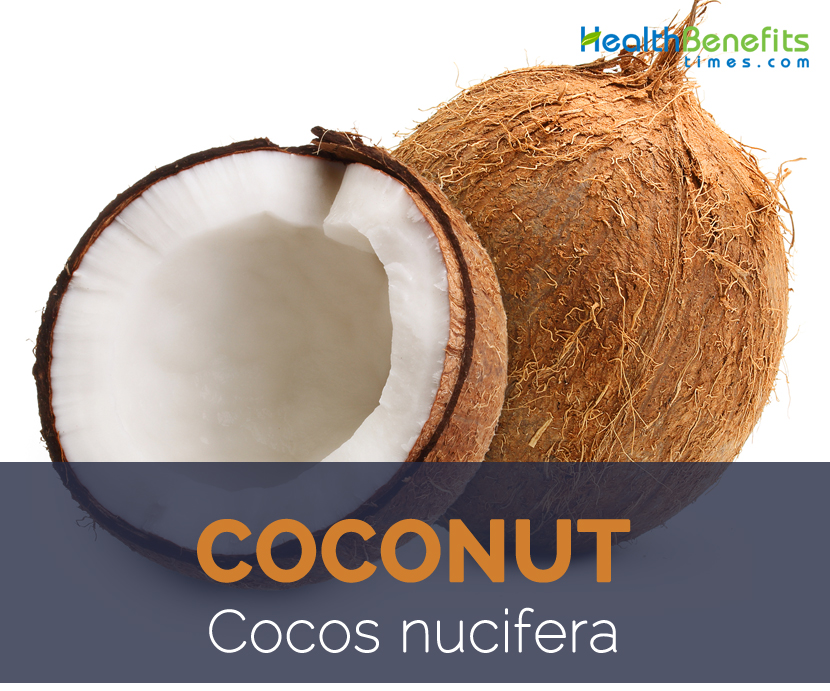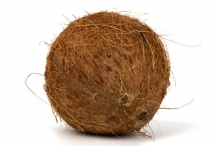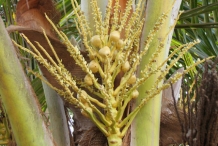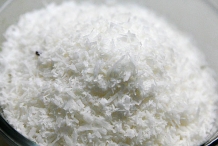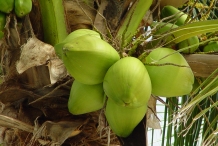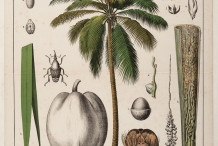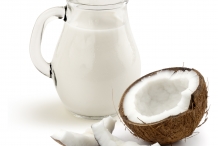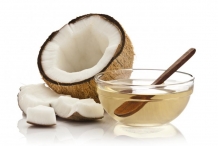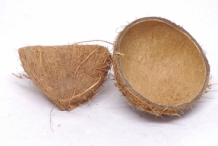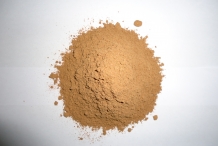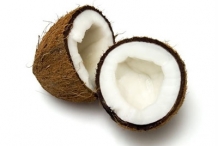Plant
Coconut is a tall, erect, single-stemmed, monoecious palm which grows up to 30 m (98 ft.) tall. It thrives best in full sun and is adaptable to wide range of soil type’s light, medium and heavy, – peaty soil, sandy, calcareous, saline to clayey soils. It tolerates alkaline soils. Though coarse sand is its natural habitat, best growth is obtained on free draining, deep soils with good physical and chemical properties. It is therefore widely grown on loams as well as clays that are well drained. Coconut is intolerant of water-logging will not survive more than 2 weeks of surface water-logging. Coconut tolerates drought poorly. It has fibrous root system and slender, more or less curved or inclined, stout trunk, 30–45 cm diameter. Leaves are frond-like, 2–6 m long, clustered at top of trunk, pinnatisect whereas leaflets are 0.6–1 m long, narrow, linear-lanceolate, bright green, inserted on rachis in 2 ranks. Plant produces both the female and male flowers on the same inflorescence; therefore, the palm is monoecious. Male flowers with six creamy-yellow perianth segments surrounding six stamens, pistillode topped by 3 nectar glands. Female flowers are sweet-scented, larger, globose, with 6 creamy-yellow perianth segment in two whorls, with 6 staminodes, 3-locule ovary, and a trifid stigma.
Fruit
Botanically, the coconut fruit is a drupe, not a true nut. It consists of, from the outside in, a thin hard skin (exocarp), a thicker layer of fibrous mesocarp (husk), the hard endocarp (shell), the white albuminous endosperm (kernel), and a large cavity filled with fluid (“coconut water”). Coconuts sold in the shops of non-tropical countries often have had the exocarp (outermost layer) removed. The mesocarp is composed of a fiber, called coir, which has several traditional and commercial uses. The shell has three germination pores (micropyles) or “eyes” that are clearly visible on its outside surface once the husk is removed. When immature, the exocarp is usually green, yellow or sometimes bronze, becoming brown when mature. Wide variation in fruit shape exocarp color, green, yellow, reddish-brown, etc. and size exist within types and populations. Fruit is usually elongated, ovoid; ellipsoid to almost spherical weighs between 0.85 and 3.7 kg. Seed comprises the dark brown shell, kernel, cavity and embryo.
History
Coconut has been the subject of much interpretation and speculation in regard to its natural origin because of its wide distribution and cultivation in the tropics and subtropics. It is supposed that the coconut palm is native to coastal areas (the littoral zone) of Southeast Asia (Malaysia, Indonesia, Philippines) and Melanesia. It is supposed that in prehistoric times wild forms (niu kafa) eastwards into the central Pacific to the tropical Pacific islands (Polynesia, and Micronesia) and westward to coastal India, Sri Lanka, East Africa, and tropical islands (e.g., Seychelles, Andaman, Mauritius) in the Indian Ocean. Coconut is either an introduction in the pre-Columbian times or possibly native to the Pacific coast of Central America. Today due to its higher nutritional value as well as it wonderful health benefits it is grown throughout the world with suitable environment.
Nutritional Value
Apart from their mild and sweet taste, coconut is a good source of nutrients, vitamins and minerals. Consuming 80 gram of coconut offers 26.79 g of Total Fat, 1.2 mg of Manganese, 0.348 mg of Copper, 1.94 mg of Iron, 7.2 g of Total dietary Fiber, 8.1 µg of Selenium, 90 mg of Phosphorus and 12.18 g of Carbohydrate. Moreover many Amino acids 0.031 g of Tryptophan, 0.097 g of Threonine, 0.105 g of Isoleucine, 0.198 g of Leucine, 0.118 g of Lysine and 0.05 g of Methionine are also found in 80 gram of Coconuts.
Health benefits of Coconut
The coconut is actually an exotic fruit which is well-known because of its dietary advantages. Its meat, juice as well as oil are well-known around the world because of its delicious flavor as well as large quantity of vitamins, minerals as well as nutrition. Coconut was utilized by ancient individuals to deal with numerous health conditions, and is also still identified nowadays because of its nutritious as well as therapeutic qualities. Let’s explore more of the amazing health benefits of coconuts and what they have to offer.
1. Good for your heart
As we all know that coconut is low in sodium and high in potassium so it is an excellent food for people suffering from high blood pressure. As coconuts contain no Tran’s fats and are gluten-free, they are loaded with high amounts of dietary fiber, and therefore are good for your heart. Coconut not only improves the cholesterol ratio in your body, but also protects your arteries from damage.
2. Weight management
Coconuts are wonderful source of fiber and low in calories which means that they make you full faster, and in turn beat hunger pangs. Apart from that it also increases your metabolic rate thereby promoting weight loss. They not only prevent obesity but also its related health complications.
3. Blood sugar control
The presence of fiber in coconut slows down the release of glucose into the bloodstream which in turn drops the blood sugar levels and controls other problems caused due to diabetes. Apart from that, they also help decrease the amount of strain on the pancreas, helping them function optimally.
4. Protects against infection
Coconuts are loaded with a myriad of healthy nutrients which helps to boost immunity and keeps diseases at bay. Apart from that it also has antibacterial, antiviral and antifungal properties that help protect you from a wide range of infections and support overall immune functions.
5. Improves digestion
As most of us are unaware of the fact that coconut is an excellent source of good fats (MCTs – medium chain triglycerides) which are quite beneficial for people with digestion problems. It also improves bowel movement and digestion in addition to helping in nutrient absorption.
6. Prevents skin infection
Regular use of coconut oil or milk topically helps in shielding the skin from numerous infections in addition to combating symptoms of skin infections like dermatitis, eczema and psoriasis. It acts as a natural aid to prevent sagging skin, age spots and wrinkles along with softening your skin. Coconut not only helps maintain the chemical balance of your skin but also provides protection against harmful UV rays.
7. Promotes hair growth
Coconuts and their by-products are certainly the best natural aids when it comes to promoting hair growth and preventing hair loss. As coconut milk is loaded with a wide range of healthy nutrients, using it on a regular basis reduces hair loss and hair breakage. Furthermore, applying or massaging coconut oil to your scalp makes your hair strong in addition to controlling dandruff and promoting hair growth.
8. Gives your energy levels a boost
In case you are feeling tired or stressed out, have a few pieces of coconut to boost your energy levels naturally. It is one of the best nutritional sources of instant energy that improve physical endurance as well as athletic performance. Coconut also helps in relieving symptoms of chronic fatigue syndrome in addition to providing extra energy.
Health benefits of Coconut oil
1. Hair care
Coconut oil helps in healthy growth of hair and gives your hair a shiny quality. It is also effective in reducing protein loss, which may cause various unattractive or unhealthy qualities in your hair. It is used as hair care oil and is used in manufacturing various conditioners and dandruff relief creams. It is normally used topically for hair care.
Coconut oil is widely used in the Indian sub-continent for hair care. It is an excellent conditioner and helps the re-growth process of damaged hair. Apart from that it provides the essential proteins required for nourishing and healing damaged hair. Research studies indicate that coconut oil provides better protection to hair from damage caused by hygral fatigue.(1), (2)
2. Weight loss
Coconut oil is considered quite beneficial for weight loss. It contains short and medium-chain fatty acids that help in taking off unnecessary weight. Research suggests that coconut oil helps to reduce abdominal obesity in women. It is also easy to digest and it helps in healthy functioning of the thyroid and endocrine system. Additionally, it increases the body’s metabolic rate by eliminating stress on the pancreas; thus burning more energy and helping obese and overweight people lose the weight. Hence, people living in tropical coastal areas, who use coconut oil every day as their primary cooking oil, are usually not fat, obese or overweight.(3)
3. Candida
Candida which is also known as Systemic Candidiasis, is actually a disastrous disease caused from excessive and uncontrolled growth of yeast called Candida Albicans in the stomach. Coconut offers relief from the inflammation caused by candida, both externally and internally. Its high moisture retaining capacity keeps the skin from cracking or peeling off. Capric acid, Caprylic acid, caproic acid, myristic acid and lauric acid found in coconut oil help in eliminating Candida albicans.
4. Healing and Infections
Coconut oil when applied to infected areas forms a chemical layer that helps to protects the infected body part from external dust, air, fungi, bacteria and viruses. Coconut oil is extremely effective on bruises because it speeds up the healing process of damaged tissues.
5. Stress relief
Coconut oil is quite soothing and therefore it helps in eliminating stress. Applying it to the head, followed by a gentle massage, helps to eliminate mental fatigue. According to research virgin coconut oil gives relief from stress and has antioxidant properties.
6. Bones
As mentioned earlier, coconut oil improves the ability of our body to absorb important minerals. These include calcium and magnesium, which are essential for the development of bones. Therefore, it is very useful to women who are susceptible to osteoporosis after middle age.
7. Dental care
Calcium is an important component of our teeth. Since coconut oil accelerates absorption of calcium by the body, it helps in developing strong teeth. It also stops tooth decay. Recent research suggests that coconut oil is beneficial in reducing plaque formation and plaque induced gingivitis.
Health benefits of Coconut Water
1. Boosts Hydration
Ingredients present in coconut water are effective at hydrating the human body than those of sports and energy drinks. During severe exercise or extended periods of physical activity, the human body loses mineral-rich fluids. However, coconut water serves as an excellent replacement medium with 294 mg of potassium and 5 mg of natural sugar per glass, unlike your favorite sports drink that only contains half of the potassium content and five times the amount of processed sugar. Additionally, the sodium count is only 25 mg, which is comparatively low compared to the 41 and 20 mg found in sports drinks and energy drinks respectively.
2. Reduces Blood Pressure
In certain cases, unbalanced level of electrolytes can result in high blood pressure. Coconut water contains an adequate supply of electrolytes so it can be used as a balancing mechanism. Apart from that it is also recommended that coconut water must be consumed at the start of each day to foster the balance of these electrolytes.
3. Relieves Hangovers
Coconut water is one of the wonderful natural remedy for hangovers. Alcohol robs your body of hydration and this dehydration causes your morning-after booze blues. Coconut water fills the electrolytes in the body and boosts hydration, therefore making you feel better.
Also, the antioxidants in this revitalizing health drink fight oxidative stress caused by indulging in too much alcohol. It will also help settle an acid stomach.
You can simply make a smoothie by mixing 2 cups each of unsweetened coconut water and ripe mangoes, 2 to 3 tablespoons of lemon juice, 2 fresh mint sprigs and ½ cup of ice.
4. Treats Headaches
Most headaches, even migraines, are caused by dehydration. In such cases, coconut water can be of great help in supplying electrolytes to the body and boosting hydration.
Coconut water is also rich in magnesium. People who suffer from migraines often have low levels of magnesium. Researches also suggest that magnesium can help reduce the frequency of migraine attacks.
https://www.youtube.com/watch?v=SeG1PmH2CKY
How to Eat
- Palm heart or palm cabbage serves as a vegetable, used in salads, or in food dishes like lumpia, achara, spring roll and also made into pickles in coconut vinegar.
- Pith of the stem contains starch which may be extracted and used as flour.
- If a matured nut is allowed to germinate, its cavity fills with a spongy mass called ‘bread’ which is extracted from the germinated nut eaten raw, baked or toasted in shell over fire.
- It makes a soft food for babies and elderly people.
- Sometimes it is scraped out, mixed with toddy, and eaten with fish.
- Sprouting germinating seeds may be eaten like celery.
- Unopened inflorescence can be tapped for its sweet sap which is rich in nutrients and has a vitamin C content of 16–30/100 g.
- On fermentation the sap is converted into an alcoholic beverage with alcohol content up to 8%, called ‘toddy’ in India, Sri Lanka and Malaysia; ‘Nam-tanmao’ in Thailand; ‘tuba’ in Philippines and Mexico; and ‘tuwak’ in Indonesia, or ‘tuak’ in East Malaysia. Coconut toddy is consumed fresh as an alcoholic beverage.
- After standing a few weeks, it becomes vinegar.
- On distillation, a liquor called ‘lambanog’ in Tagalog, or arrack, is obtained from toddy.
- Commercial arrack obtained by distillation of coconut toddy is known as coconut fenny in Goa, India.
- Sap can be processed into coconut sugar or jaggery after collection and filtration.
- Filtrate is boiled down into sticky brown, thick syrup called coconut molasses.
- A technique developed by the Thailand Horticultural Research Institute produces granulated coconut sugar for use in instant coffee or tea.
- Sometimes the dark sugar is mixed with grated coconut for candy. Toddy was also used as a source of yeast.
- Coconut nectar is an extract from the young bud; a very rare type of nectar collected and used as morning breakfast drink in the islands of Maldives, and is reputed to have energetic power.
- A by-product, a sweet honey– like syrup called dhiyaa hakuru is used as a creamy sugar for desserts.
- Young, green coconut and mature, old coconuts are harvested and eaten.
- Fermented ripe nuts have a tough flesh that is sour and oily and some people enjoyed its special flavor.
- Sweet and fairly soft husk is chewed.
- Small nuts formed after the flower has set on trees of this variety are also eaten.
- Coconut water from young green coconuts makes a refreshing, nutritious drink chilled or otherwise and the young soft white meat is taken out and mixed with the coconut water and eaten.
- Coconut water is sold in plastic bags, canned, or frozen in Thailand.
- Meat from young coconuts is eaten separately as snack or in fruit salads or mixed with other ingredients in various dessert.
- Flesh is soft and spongy, making an excellent baby food.
- It is also used in confectioneries and in making pies.
- Macapuno is a freak coconut with soft, tender and jelly-like meat which fills up the whole nut cavity in Philippines.
- Macapuno is used in confectionery and bakery items, ice-cream and fruit salads.
- Kernel meat from mature coconut is made into chips, desiccated coconut and grated coconut for extraction of coconut milk.
- Coconut chips are made from thinly sliced, dried matured coconut meat. They are usually served as snack food in parties.
- Fresh, grated coconut meat is packed and sold in plastic bags in local markets for immediate use.
- Grated coconut is used in confectioneries and bakery – biscuits cakes and candies.
- Bukayo is a popular dessert delicacy made from freshly grated coconut, molasses and corn syrup in Philippines.
- Grated coconut are pressed and filtered through a cloth to obtain the white rich, coconut milk.
- Coconut milk is extensively used in Asian and Pacific cuisine; in vegetable, prawn, fish, chicken, beef curries; laksa noodles; soups, cooked with rice to make Panama’s famous arroz con coco; also cooked with taro leaves, and used in coffee as cream.
- Coconut milk mixed with other ingredients makes a very refreshing drink such as pina colada which is also available in cans in Philippines.
- Coconut jam is a mixture of coconut milk and brown sugar, commonly used as bread spread and dessert.
- Coconut honey is made from coconut milk and is a good substitute for honey and is used as bread spread.
- Coconut milk is used widely in various types of desserts: with red beans or green gram porridge; black glutinous rice dessert called pulut hitam in Malaysia; with rice or tapioca starch desserts; fruits like jackfruit, bananas; root crops like taro, tapioca, sweet potato, and vegetables like pumpkin.
- Desiccated coconut is the white dehydrated, shredded kernel meat of coconut, used mostly in a variety of edible food processing, including the production of confectionery and bakery products, canned and frozen foods and as a commercial and domestic cooking ingredient.
- Dessicated coconut is available in granular flakes or shredded form of varying sizes and shred lengths to match the need of confectionery, pastry or baking requirements.
- Coconut flour is the pulverized, clear white powdery, food grade residue from pressed and or solvent extracted, dehydrated coconut meat.
- A combination of 10 parts coconut flour to 90 parts wheat flour is used in the baking of bread and biscuits to increase the food’s protein value.
- Coconut water can be fermented with brown sugar and yeast to obtain coconut vinegar.
- Coconut vinegar is used in the preservation of fruits and vegetables and the preparation of pickles, sauces, chutneys and other manufactured products.
- Nata de Coco, a popular gelatinous dessert is produced by brewing a species of the vinegar group of bacteria in sugared coconut water and coconut skim milk media.
- It is also used as an ingredient in the preparation of other desserts and confectionery.
- Coconut oil is the natural oil obtained from copra or fresh kernel meat.
- Copra can be made by smoke drying, sun drying, or kiln drying.
- Edible grade of copra is consumed as a dry fruit and used for religious purposes in India.
- Copra is the dried kernel meat of a matured coconut and is eaten as emergency food in the Pacific islands.
- Coconut oil is commonly used in cooking, especially when frying.
- In communities where coconut oil is widely used in cooking, the unrefined oil is the one most commonly used.
- Coconut oil is normally used to flavor many South Asian curries.
- Coconut oil is usually made from copra and is used for home cooking and commercial food processing besides cosmetic, industrial, and pharmaceutical purposes.
Other Traditional uses and benefits of Coconut
- Very young, immature, aborted coconut has been used in dysentery as an astringent mixed with opium and some flavoring material in Java, and as external applications for hemorrhoids, ulceration of the bone and ulcerative colitis and internally for fever in Peninsular Malaysia.
- Coconut water is supposed to be an antidote against choleric attack and a diuretic assisting in removal of irritant substances in the blood.
- It is considered as antiscorbutic and somewhat anthelmintic.
- Coconut water has been reported to be a tonic for the old and sick, to stop urinary infections and to be effective in treatment of kidney and urethral stones in India.
- Water from the young coconut has been used as a substitute for dextrose infusion in emergent situations during World War II and drank for diarrhea and vomiting.
- Santans (coconut milk) are commonly used as a vehicle for Malay medicaments internally used and externally applied.
- It is also found to be good on the skin as moisturizer.
- Gata (coconut milk) is employed for constipation in Philippines.
- Grated kernel meat with scraping of porcupine quills are burned together and the ashes administered as a remedy for cholera.
- Ash from burnt fruit stalks is used after confinement to protect against evil spirits.
- Kernel of young fruit mixed with other ingredients is sand-rubbed on stomach against diarrhea.
- Roots are considered antipyretic and diuretic.
- Roots are believed to be anti-blenorrhagic, anti-bronchitis, febrifugal, and anti-gingivitic.
- Young roots are used astringent for sore throats in Philippines.
- Root infusion is used for dysentery and other intestinal complaints and for coughs in Indonesia.
- Decoction of pulped roots has been employed for small pox and as poultice in syphilis, gonorrhea and rheumatism in Peninsular Malaysia.
- Immature coconut flowers are considered as astringent and chewed for gonorrhea.
- Pounded coconut leaves placed in water is sprinkled over fever patients.
- Coconut oil is used to treat dandruff and dry skin.
- Ash of the bark is used for scabies in the Philippines.
- The Indian system of medicine known as Ayurveda is replete with instances of the use of coconut oil in various medicinal preparations.
- The decoction of Cocos nucifera husk fiber is used in northeastern Brazil traditional medicine for treatment of diarrhea and arthritis and tea from the husk fiber is widely used to treat several inflammatory disorders.
Other Facts
- Coconut tree has often been dubbed the ‘tree of life’, ‘tree of plent’, ‘tree of abundance’ or ‘tree of a thousand uses’.
- Indeed an extremely useful tree where every part of the tree from the roots, trunk, growing shoot, leaves, inflorescence, flowers, fruit and fruit parts are ubiquitously and economically used for a numerous of edible and non-edible products and applications.
How to store Coconut
Purchase fresh new, complete coconut or even processed or perhaps packed coconut. Canned as well as packaged coconut is refined as well as offered shredded, flaked, and grated in sweetened as well as unsweetened types. Fresh as well as dried coconut pieces may also be accessible.
- Unopened coconuts could be saved at room temperature for approximately 4 months.
- After the coconut is broken, firmly cover the coconut meat as well as store it within the fridge for approximately Five days.
- Use fresh coconut milk as well as water within just a couple of days.
- Place fresh grated coconut within a firmly covered container (or plastic bag) as well as refrigerated for approximately 4 days or even frozen for approximately Six months.
Disadvantage of Coconut
Coconut oil has its drawbacks as well as shortcomings in spite of its healthy qualities. Let’s review them one at a time and find out the way we can change every disadvantage to your favor so that you can reduce its unfavorable effect as well as increase its health advantages for you.
1. No Effect on “Cold”
The medium-chain fatty acids (MCFAs) within coconut oil can easily destroy various kinds of viruses, which includes influenza virus which causes flu. However they are hopeless from the rhinovirus that creates common cold. In reality, no medicines or even herbal treatments can easily combat with rhinovirus, except the body defense mechanisms.
However, when you are down along with cold, the infection could leave your defense mechanisms susceptible to attack by a lot more bacteria, germs as well as viruses. That is where MCFAs within the oil come into play.
MCFAs assist you to kill people dangerous microorganisms as well as relieve the load off your defense mechanisms so it can concentrate on battling the cold virus successfully. Therefore it is still vital that you consume coconut oil whenever cold attacks you.
2. Excessive Coconut Oil May Harm
Simply because everybody says it really is nutritious does not mean you begin scoffing a lot of it. An excessive amount of an excellent might do you more damage than good. You might wind up running diarrhea-like symptoms in case your body is not used to these kinds of unexpected alter.
Go slow along with 1 tablespoon first as well as progressively improve to 3 or 4 tablespoons each day. Distribute the dose during the day rather than gulping down few tablespoons at one go. That will help you stay safely and securely while enjoying the oil’s health advantages.
3. Flavor Sucks!
The majority of people adore its fragrant taste. However, just like durian, some individuals might not enjoy it. Therefore, in case the initial smell or even taste of coconut oil simply does not suit your needs, fret not, you still have 2 options.
o Mix it in the food items or even drink that contains powerful taste that will well cover the health-promoting virgin coconut oil’s initial scent.
o Use RBD (processed, bleached as well as deodorized) coconut oil exactly where it offers extremely mild or even no odor of coconut oil. Yet be sure you receive the genuine RBD oil type without having hydrogenation or even its trans fatty acid content (hydrogenation can produce trans fatty acid) might cause irrevocable harm to your overall health.
4. Contains high amount of saturated fat
Coconut includes large quantities of saturated fats, which usually happens to be much less healthy and balanced than other kinds of fat. However, more than 50 % of the fatty acids within coconut originate from lauric acid, which is antiviral as well as anti-bacterial and is also incredibly valuable in battling an infection. Because of this, coconut is usually regarded as healthy in its all-natural form, yet has significant disadvantages when it is processed in unpleasant methods. As an example, hydrogenated coconut oil is changed in a manner that eliminates the lauric acid and has been shown to block arteries and reduce heart health.
Ways to Eat Coconut
The coconut is probably the very useful plants on this planet. Several cultures make use of nearly every portion of the tree through the leaves towards the water within the coconut fruit. In reality, the water is sterile and clean, as well as was utilized like a intravenous solution within a pinch throughout World War II. The flesh of the coconut fruit, the fluid within the coconut, coconut milk (made from liquid squeezed from the coconut flesh) and also the root of the palm, referred to as hearts of palm, are generally consumed. Below are a few methods to experience the various areas of the coconut:
1. Batter
Think coconut-breaded shrimp. Make use of flakes of coconut flesh to cover shrimp as well as bake or even fry. You may also coat various other sea foods, just like tilapia, or even try chicken along with dried out coconut flakes.
2. Salad
Hearts of palm are generally collected through the root of a palm tree. Achieving this kills the whole tree, therefore a salad made out of the root once was known as a “millionaire’s salad.” Nowadays, instead of utilizing coconut palms or any other varieties, most heart of palm originates from the peach palm-the only palm varietal not to die right after its root has become collected. Hearts of palm have got a delicate taste comparable to asparagus or even artichoke. Paula Deen includes a recipe for the salad along with spinach, strawberry as well as hearts of palm.
3. Curry
Coconut milk is definitely the foundation for a lot of Thai curries. We can make rich and creamy red curry making use of red curry paste, a can of coconut milk, chicken as well as sweet potato. To learn more, plus some genuine recipes, Serious Eats like a nice breakdown of curry type along with recipes.
4. Substitute for dairy
We can prepare quality recipes making use of coconut milk rather than dairy milk to follow kosher laws is interesting. Get this particular Sweet Potato Coconut Crumble from Gourmet Kosher Cooking or even these coconut milk scalloped potatoes. Coconut milk may also function as the base of non-dairy ice creams for all those lactose-intolerant ice cream lovers. Grist recently reviewed non-dairy ice cream choices, as well as the coconut milk types won.
5. Piña Colada
Several snows through the great snow storm of 2010 still is lingering on the floor within D.C., yet it’s currently March as well as spring will be here soon. When it begins to warm-up, fix yourself a piña colada as well as imagine you’re on the exotic beach someplace. This particular well-liked cocktail is made of rum, pineapple juice as well as cream of coconut, that is produced from coconut milk.
6. Toast
Toast peeled strips of coconut within a dry skillet above lower warmth till browned as well as aromatic, about Ten minutes. Spread coconut strips above oat meal or even granola, or perhaps toss all of them with nuts as well as dried fruit for an easy-to-eat as well as fulfilling hiking or even travel snack.
7. Sprinkle
Spread perfectly grated coconut–fresh or even toasted on the exotic fruit salad of fresh mango, papaya, orange, as well as banana.
8. Mix
Combine cooled coconut juice with just a few splashes of ginger beer along with a squeeze of lime to get a delicious exotic drink.
9. Coconut Cookies
Heat em’ up, eat em’ up, if someone else takes one beat em’ up.
Ahi, baby shrimp as well as hamachi ceviche – Cool and also rejuvenating for the summer time swelter.
10. Coconut Curry Chicken
Enhance your daily life suckfish, include some scotch bonnet habaneros.
11. Coconut Macaroon Pancakes
Breakfast, lunch or even dinner, these types of flapjacks may have you saying’ fuckadenny’s, there is nothing just like home cooked.
12. Coconut Rice
This is the way to do whatever you do whenever you do what you do.
13. Fresh Coconut Cake
Traditions exists for a reason, this particular one’s a guaranteed hit.
14. Pain In The Ass
Alcoholic drink well-known within the Keys that can take its title from how bartenders feel about it when they have got lots of clients. Makes use of coconut rum as well as five various other components.
15. Coconut Shrimp
There are numerous million methods to try this therefore we are connecting you to definitely a resource using a lot of tips.
References:
https://en.wikipedia.org/wiki/Coconut
https://www.loc.gov/rr/scitech/mysteries/coconut.html
http://coconutresearchcenter.org/
http://www.medicalhealthguide.com/articles/coconut.htm
http://www.cabi.org/isc/datasheet/11788
https://npgsweb.ars-grin.gov/gringlobal/taxonomydetail.aspx?id=11043
http://davesgarden.com/guides/pf/go/55280/
Comments
| Coconut Quick Facts | |
|---|---|
| Name: | Coconut |
| Scientific Name: | Cocos nucifera |
| Origin | Native to coastal areas of southeast Asia |
| Colors | Light green when young, which becomes dry and turn gray as the nut matures |
| Shapes | Elongated, ovoid, ellipsoid to almost spherical |
| Flesh colors | White |
| Taste | Mild and Sweet |
| Calories | 283 Kcal./cup |
| Major nutrients | Total Fat (76.54%) Manganese (52.17%) Copper (38.67%) Iron (24.25%) Total dietary Fiber (18.95%) |
| Health benefits | Good for your heart, Weight management, Blood sugar control, Protects against infection, Improves digestion, Prevents skin infection, Promotes hair growth, Gives your energy levels a boost, Candida, Healing and Infections, Stress relief,Bones,Dental care, Boosts Hydration, Reduces Blood Pressure,Relieves Hangovers, Treats Headaches |
| More facts about Coconut | |
| Rank | Scientific Name & (Common Name) |
|---|---|
| Kingdom | Plantae (Plants) |
| Subkingdom | Tracheobionta (Vascular plants) |
| Superdivision | Spermatophyta (Seed plants) |
| Division | Magnoliophyta (Flowering plants) |
| Class | Liliopsida (Monocotyledons) |
| Subclass | Arecidae |
| Order | Arecales |
| Family | Arecaceae (Palm family) |
| Genus | Cocos L. (Coconut palm) |
| Species | Cocos nucifera L. (Coconut palm) |
| Synonyms |
|


